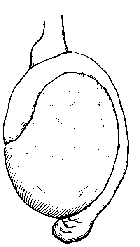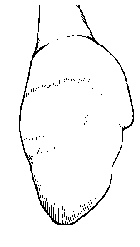

| Normal testicle | Diseased testicle |
Introduction:
Ram epididymitis is a reproductive disease that causes inflammation of the epididymis in the male reproductive tract. The epididymis is the tubular portion of the testicle that collects the spermatozoa produced by the testicular tissues and stores it until transport when it is mixed with the seminal fluid to produce an ejaculate. Inflammation of the epididymis causes varying degrees of damage that can result in infertility and a reduced capacity to produce viable spermatozoa. Ram epididymitis is usually a condition of mature, sexually experienced rams. This disease is not recognized in goats. A serological survey (ELISA test) was recently conducted on 5,728 adult rams which had been exposed to multi-sire breeding systems. Out of the 5,728 rams, 20% were positive, 5% suspects, and 75% were negative. Individual flocks may experience infection rates as high as 50%.Causative Agent: Although a variety of organisms and trauma can cause inflammation of the epididymis, the cause of contagious ram epididymitis in mature rams of multi-sire breeding systems is the bacterium Brucella ovis (B. ovis).
Disease Transmission: A non-infected ram picks up the disease by homosexual activities or during the breeding season via the ewe. The B. ovis organism enters the blood stream of the ram through the mucous membranes of the penis and infects the reproductive tract and epididymis. The organism escapes from an infected ram through urine or semen. The ewe, although not permanently infected, plays a role in the mechanical transmission.
Clinical Signs: This infection causes inflammation and scarring of the ramís reproductive tract, which results in impaired semen production and lowered semen quality. Enlargement and fibrosis (scarring) of the epididymis with shrinking of the testicular tissue is the classic clinical sign. In many cases, however, the infection of the secondary sex organs (prostate, bulbourethral gland) occurs without the epididymis being infected. These rams do not have lesions that can be felt and must be identified by semen evaluation and serology. In some cases, B. ovis infections in ewes can cause abortions or death of newborn lambs.
|
|
||
|
Diagnosis: Diagnosis of B. ovis induced ram epididymitis is by palpation of the testicle and epididymis for fibrotic lesions; however, this method does not detect those animals with infection of the secondary sex organs. These rams must be diagnosed by semen examination for the presence of white blood cells (WBC) and spermatozoal abnormalities. Both types B. ovis infections can be diagnosed by semen culture or by serology. Currently, the enzyme linked immunosorbent assay (ELISA) is being used for early detection of B. ovis infections.
Treatment/Prevention:
Antibiotic treatment of B. ovis is disappointing because about half the cases will not respond, and many animals continue to have decreased fertility. Prevention is based on eradicating the disease from an infected flock and purchasing disease free rams. A producer should purchase only "virgin" yearling lambs that have a negative ELISA test or are from flocks that are free of B. ovis.Eradication Procedures:
Sheep producers can now rid their flocks of ram epididymitis. The process is very time consuming, but can be rewarding if done thoroughly and properly. Documented field studies have shown that control of ram epididymitis results in a shortened lambing period, an increased twinning rate, and a reduction in the percent of dry ewes. All this is accomplished while using fewer rams. The costs of an eradication program include culling of positive rams, veterinary/lab fees for blood collection/testing, and labor. Although culling of positive testing (carrier) rams is necessary, the program is still economically feasible for most producers. The majority of rams to be culled have reduced semen quality and often serve as more of an interference than an asset to the flock. Producers interested in cleaning up their flocks should plan on at least 2-3 years of intense management and annual testing, thereafter. Quitting too soon could result in the loss of any gains achieved during the eradication efforts. For eradication, the following steps should be taken:Summary of Eradication Program Options
Plan A: (Potential for rapid cleanup)
Plan B: (May take several years)
Plan C:
Lamb Epididymitis: Many ram producing (purebred) flocks are affected with sporadic cases of epididymitis in the lamb or yearling rams being raised for sale. These cases are usually not caused by the B. ovis organism but by one of several other organisms instead. This needs to be viewed as a completely different disease process, although the signs of epididymitis are the same as those caused by B. ovis. The only known ways for these rams to be infected with B. ovis are if they are used for breeding in a range flock (leased or loaned out) or if they are mixed with adult rams that are infected. The following recommendations are to aid ram producers in reducing ram lamb and yearling ram epididymitis: